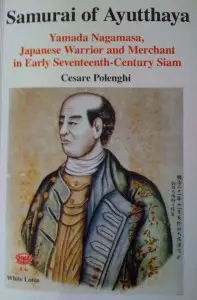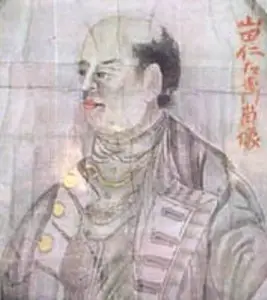
The City of Ayutthaya is one of my favourite places in Thailand. I have been there on several occasions, both by myself and together with family and friends and I can never get bored with its ancient ruins and wonderful attractions. On my trips, I have visited both the inner city and the area surrounding it and one of the places that I keep going back to is the Japanese Village, or Baan Ippun in Thai and Nihonmachi in Japanese, situated on the banks of Chao Phraya River, opposite the Portuguese Village (which is visible on the other bank).
The history of the Nihonmachi is closely related to that of Yamada Nagamasa, a Japanese adventurer who made it his home in the early 17th century, when Thailand was known as Siam and its capital city, Ayutthaya, was nearing is greatness. Tracing back the history of the Japanese Village and its most famous leader, Yamada Nagamasa, is not an easy task, as Ayutthaya was completely destroyed when the Burmese army invaded it in 1767, killing, pillaging and burning everything in its way. Still, historians continue to search for documents and, recently, Yamada’s exploits in Siam have even picked up with the public in the form of a big-screen movie.
A more scholarly approach was attempted in the form of a well-documented book by Italian-born researcher Cesare Polenghi. Samurai of Ayutthaya: Yamada Nagamasa, Japanese Warrior and Merchant in Early 17th Century Siam was published in 2009 by White Lotus, a Thailand-based publishing house that has already built a tremendous reputation with its long list of books on the Southeast Asian region. It is the first monograph written in English about Yamada Nagamasa and the Japanese who were active in Southeast Asia before 1940!
The book is structured into seven chapters, each analyzing the most (if not all) of the primary and secondary resources that Cesare Polenghi could find on the subject matter. He also deals with the tales and the representations in popular media that have been inspired by Nagamasa’s travels.
The Preface of the 80-page book places Yamada Nagamasa (1590-1630) alongside such “Japanese tragic heroes” as Minamoto Yoshitsune, Kusunoki Masashige, and Saigo Takamori. For more on other “illustrious ‘failures,’” the author recommends Ivan Morris’s Tragic Heroes in the History of Japan.
Chapter 1, A (21st Century) Tale of Yamada Nagamasa, gives us the popular version of who Nagamasa was. In doing that, Polenghi romanticizes the biography of Nagamasa and uses his imagination to fill the gaps that documents were not able to clarify. It is basically the version most Japanese have known about Nagamasa, the one that you would find in a book of tales for children. From the little information that we have about Namagasa’s early life, we know for sure that he was born in Sumpu, in Suruga province (located on the eastern coast of central Japan) in 1590, a time when Japan was entering a new era of peace and security, after a century and a half of civil war.
The difficulties researchers have painting a historically accurate picture of who Yamada Nagamasa really was is evident in The Historiography of Yamada Nagamasa, the second chapter of the book. Basically, there are no primary sources that deal directly with Nagamasa’s life and the main source about his exploits in Ayutthaya comes from the writing of a Dutch merchant, Jeremias van Villet, who lived in Ayutthaya from 1633 to 1640 and wrote extensively about what he had experienced. Polenghi also explains the influence the pro-expansion propagandistic textbooks of WWII and their subsequent dismissal by the occupying forces of the United States has had on the image of Yamada Nagamasa, the historical character.
The core subject of the research starts with Chapter 3. The Historical Landscape of Early 17th-Centrury Japan and Siam: Yamada Nagamasa and the Way to Ayutthaya presents verifiable facts concerning Nagamasa’s date and place of birth, his job as a palanquin bearer, as well as the historical context regarding Tokugawa’s policy of international diplomacy during the early part of his shogunate. The events that facilitated Nagamasa’s crossing to Siam in the early 1610s on a shuinsen, a vermillion seal ship, are dealt with in the final section of this chapter.
The Japanese in Ayutthaya in the Early 17th Century is the title of Chapter 4 and it gives an overview of the geographical, historical, political, and social situation of the Nihonmachi in Ayutthaya. According to the Siamese Royal Chronicles, in 1593, there were already 500 Japanese in Ayutthaya, many of which had taken as wives Thai women, thus helping create a whole generation of young “Japanese-Thai” adults. Most of the Japanese who worked in Ayutthaya were either merchants or warriors or, in quite a few cases, both. As elite troops in King Song Tham’s bodyguard corps and as auxiliaries in the Siamese army, the Japanese soon built a reputation for themselves and their services were valued (though loathed for their brutality). As Christianity was tolerated in Ayutthaya, it is not surprising that most of the Japanese living in Baan Ippun were Christian, with as many as 1,500 Japanese Christians living there by 1662.
 In Chapter 5, Yamada Nagamasa in Siam, 1612-30, the focus turns on Nagamasa and the events that unfolded before and after the riot at the Royal Palace in Ayutthaya in 1611, as well as the several embassies that were sent to Japan (1616, 1621, 1623, 1625, 1626, and 1629). Soon enough, Nagamasa establishes himself as a trustworthy merchant, warrior, and leader of the Japanese in Ayutthaya, title he “inherited” from his predecessor, Kii Kyuemon (who, by 1619, had either died or retired).
In Chapter 5, Yamada Nagamasa in Siam, 1612-30, the focus turns on Nagamasa and the events that unfolded before and after the riot at the Royal Palace in Ayutthaya in 1611, as well as the several embassies that were sent to Japan (1616, 1621, 1623, 1625, 1626, and 1629). Soon enough, Nagamasa establishes himself as a trustworthy merchant, warrior, and leader of the Japanese in Ayutthaya, title he “inherited” from his predecessor, Kii Kyuemon (who, by 1619, had either died or retired).
Unfortunately, the Siamese political scene of the late 1620s was highly influenced by a ruthless man called Phya Sriworawong (aka Phra Ong Lai) whose greatest desire was to become king. At the death of King Song Tham in 1628, Phya Sriworawong succeeded in getting rid of all his rivals at the Siamese court, but Nagamasa, who remained faithful to the late Song Tham’s memory, proved to stand in his way. Phya Sriworawong took the title of “the Kalahom” and devised a plan that would eventually bring about Nagamasa’s destruction.
In 1629, the Kalahom made Nagamasa the King of Ligor (today Nakhorn Si Tammarat), a province in the south that ever since the 16th century had been paying tribute to Ayutthaya. Here, the “rebel” king refused to pay tribute to Ayutthaya and Nagamasa was sent to replace him. By 1630, Ayutthaya was back in control of Ligor and the Kalahom became king after he assassinated King Athittayawong, a ten-year-old puppet-king. Although worried by the turn of events at the Siamese court, Nagamasa remained in Ligor to nurse a wound he had received in battle. He was soon to die. His death is surrounded in mystery and controversies, with two versions that both state that Nagamas was poisoned, but differ when it comes to naming the culprit.
Chapter 6, The Japanese in Siam after Yamada Nagamasa, deals with the troubles the Japanese community run into after Nagamasa’s death and their escape by ship to Cambodia after Oin, the teenage son of Nagamasa, lost control of Ligor. “[Prasat Thong’s] killing of Nagamasa and many other Japanese residents in Siam was never forgiven by the shogunate: in Edo, matters of principle seemingly counted for more than business. Thus, the Nihonmachi of Ayutthaya gradually vanished,” concluded Cesare Polenghi. The normalization of relationships between Japan and Thailand resumed in 1887, more than 250 years later!
Postwar representations of Yamada Nagamasa is the seventh and final chapter of the book. It is a brief overview of how Nagamasa has been portrayed in movies, manga, literature, festivals, and theme parks throughout Japan. The book ends with a mention of the reconstructed Baan Ippun in Ayutthaya and the obelisk from a park in Nakhorn Si Thammarat, raised in remembrance of the Japanese who died in this southern city in 1630.
Like all well-research scholarly books, the author has an extensive reference list which is preceded by notes that give extra information and clarifications on the text. Over twenty colour photographs are placed in the middle of the book, giving the readers a much-needed visual anchor that such a “heavy” book requires.
Samurai of Ayutthaya: Yamada Nagamasa, Japanese Warrior and Merchant in Early 17th Century Siam by Cesare Polenghi is not an easy book to read. It contains numerous dates, events, and names that readers, who do not have a basic understanding of the region and the historical period the book deals with, will find difficult to follow. It is an academic work targeted at aficionados of Asian history, who will find among its covers the “story” of the most intriguing Japanese character that has lived in Siam.
Yamada: The Samurai of Ayothaya (several spelling forms exist for the name of the city!) is a movie directed by Nopporn Watin that was released in 2010 to celebrate 127 years of Thai-Japanese diplomatic relations. Though historically inaccurate, it is a good introduction to the kind of life Yamada Nagamasa lived in Ayutthaya.
Video of the reconstructed Japanese Village in Ayutthaya, Thailand:


Thanks for d book synopsis. It is a pity to know that movie makers manipulate history but still claiming “based on true story”.